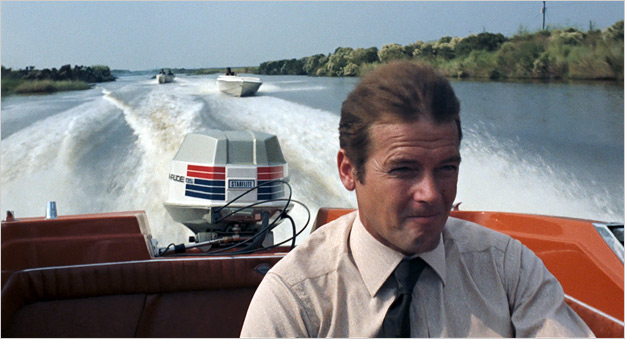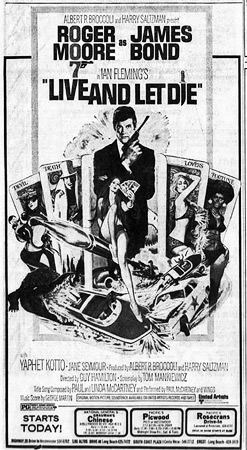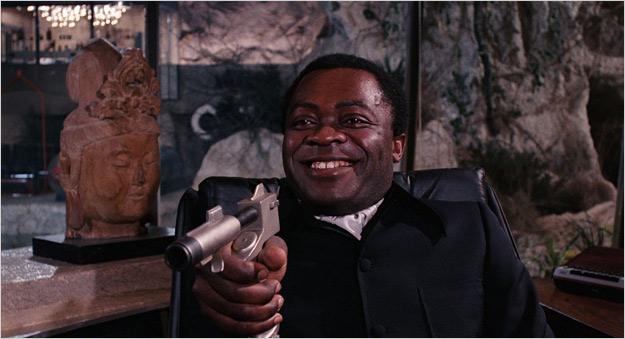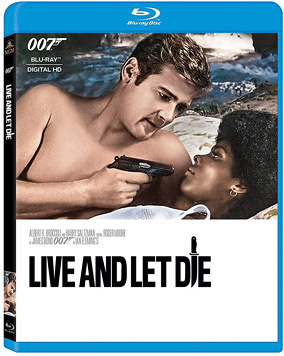
Coate: In what way was Yaphet Kotto’s Kananga/Mr. Big a memorable villain?
Burlingame: I have always loved Yaphet Kotto. Even sat next to him during a press conference back in the ’80s or ’90s when he was in some TV-movie I was covering for United Features. His roles in Raid on Entebbe, Alien and Homicide are all personal favorites. It takes an actor of power and substance to take on James Bond and he filled the bill nicely (although I found the inflating-and-exploding Kananga finale too ridiculous and another example of over-the-top Bond that would get worse and worse as the decade progressed).
Cork: Yaphet Kotto is an underrated actor, and was, I feel, a great choice for Big Kananga, an ambitious drug kingpin who is…wait for it…ultimately trying to sell more drugs. But Big Kananga suffers from VDS or Villain Derangement Syndrome. This is where a character starts off as a brilliant adversary but during the course of the film grows steadily more and more insane, developing twitches, ticks, a nervous laugh and often leads to an embarrassingly stupid death. Big Kananga endures the worst villain death in any Bond film. I am not sure how the fatal flying fart got into the final draft, but it is the lowest point in an otherwise excellent film. Yet, even that deadly flatulence is historic. It would be over half a year on before Mel Brooks would subject audiences to the campfire scene in Blazing Saddles. While the very tame 1959 Japanese family film, Good Morning, featured numerous farts, I don’t know of any other major motion picture, British or American, to feature flatulence before Live and Let Die. Everyone can ask someone to pull their finger in celebration.
What saves Big Kananga from diminishing the film by his small-time hoodlum ambitions are his henchmen. They really make the film. While Whisper (Earl Jolly Brown) has too little to do, Arnold Williams as “Cab Driver 1” chews up the scenery delightfully. Julius Harris as Tee Hee delivers a master class in villainy with just a few lines and a fantastic smile. And then there is Geoffrey Holder as Baron Samedi. Holder was a giant of a man who fills the screen, moves with the fluidity of an octopus, and has more charm in his little finger than one can find in the entire casts of most films. Holder also brought some wonderful lore to the Bond film. He had played Baron Samedi before in Truman Capote’s Broadway musical, House of Flowers. He also knew Ian Fleming, whom he thought was a terrible British snob. He told a story of having Ian Fleming to his apartment for dinner in New York and intentionally spicing Fleming’s food so that it “burned his ass.” I think it is brilliant that the film closes on (spoiler alert) Baron Samedi laughing at the audience.
Howard: He is absolutely brilliant in this film: a complete black movie star. He’s handsome, has a great speaking voice and he has tremendous screen presence. I had seen Kotto in Bone before seeing him in Live and Let Die so I knew who he was. I sort of confused him with Sidney Poitier, both talented, imposing and erudite black men. He’s a fascinating actor and, in my opinion, his contribution to the film is as important as Roger Moore’s. His accomplishment is all the more noteworthy when you consider the fact that he’s playing a dual role. He’s both Kananga, an international drug smuggler and Mr. Big, an inner-city drug seller. Kotto plays it all perfectly: laid back, secure, aware of his power and influence — even in that prosthetic mask and wig!
Pfeiffer: Yaphet Kotto was already an established character actor and well-respected. He rode the recent wave of blaxploitation films to elevate his career even further, but Kotto had already been a well-regarded actor since the 1960s, appearing in films like 5 Card Stud and The Thomas Crown Affair. The role of Kananga provided him with his most substantial role to date and he made the most of it, making history in the process as the first African American actor to play the main Bond villain. Despite the racial component, Kotto provided all the key characteristics of the traditional Bond bad guys: he was elegant, handsome, sophisticated and witty — even when he was about to kill someone. He’s a fine actor and provided a memorable performance.
Scivally: In some ways, Mr. Big/Dr. Kananga is the original Janus, a two-faced villain who goes from gruff and streetwise (Mr. Big) to urbane and sophisticated (Dr. Kananga). The two diverse personas also act as a doppelganger of 007 himself, who is both deadly assassin and suave seducer. Yaphet Kotto seems more at home in the character’s Dr. Kananga incarnation; while Mr. Big is a cartoon caricature of a Harlem gangster, Kananga is more sinister — cool and calculating one moment, and passionately violent the next. He’s memorable for being the first black Bond villain, and indeed this film employed more black actors than had seemingly appeared in the entire 007 series up to this point. Julius Harris, Earl Jolly Brown and Tommy Lane were engaging henchmen, Lon Satton was amusing as CIA agent Strutter, Gloria Hendry made the most of her thankless role as inept turncoat Rosie Carver, and the presence of actor/choreographer Geoffrey Holder’s Baron Samedi added a nice grace note to the climax.
Sherman: Yaphet Kotto is a skilled actor and is believable in his dual roles as a wealthy and erudite political leader and also a hardened, murderous drug dealer. His transformation via prosthetics works well on screen and the look of surprise on Bond’s face is deserved. Kotto presents a large range of emotions on screen, making his character multidimensional. He rages at times, but we see him struggling to keep his emotions in check. He’s one the best things about the film, and Bond needs a great antagonist like Mr. Big to have a great film.
Coate: In what way was Jane Seymour’s Solitaire a memorable Bond Girl?
Burlingame: I just loved Jane Seymour as Solitaire. Loved her. There was something so innocent about her in those early scenes; she had done other films — I would have seen her in Young Winston in ’72 but don’t remember it well — but this was her first big splash as an actress. She was ideal casting, and I followed her career for many years afterwards (especially notable against a John Barry score in Somewhere in Time, 1980, and then as the bad girl Cathy in TV’s East of Eden miniseries in 1981).
Cork: I think Seymour does a fantastic job with the role. Solitaire never feels like a carbon copy of prior women in the Bond films. There is an interesting moment where Bond is about to be taken up in a plane and tossed out. She creates a distraction by pretending to attack him, allowing him to fight back and eventually escape. Seymour never telegraphs this moment. She gives a quick glance at the cab driver then steps out purposefully and walks up to Bond with convincing distaste. At no point does she come across as fragile or even as a damsel in distress, and considering the character was written as a damsel in distress, that speaks to her presence. Seymour creates a very attractive imperiousness about Solitaire, and even in one of the film’s best scenes, where her infidelity is discovered by Big Kananga, she plays her uncertainty and anxiety very genuinely. It should be noted that she was largely dubbed by Nikki van der Zyl, who certainly reflected Seymour’s steely-eyed physical performance in the re-voicing work.
Of all of Bond’s seductions, his use of a cheap card trick to play on the superstitions of Solitaire is the most divisive. Men generally find it tremendously amusing. Women stand united that this crossed an ethical line. Fortunately, Solitaire seems quite comfortable with her #MeToo moment, and the incident appears to be in little danger of getting the Ronan Farrow treatment in The New Yorker.
Since there are long gaps between Seymour’s appearances, special nods should be given to Madeline Smith and Gloria Hendry, who both bring a lot of fun to the film with smaller but significant parts. Hendry in particular makes a bit of Bond history with her love scene with 007.
Howard: Well, I love her character’s name and she’s got a great role. Is she a witch, a soothsayer, a palm reader? We’re never really sure but she certainly has no problem predicting the future. Love negates her powers of course and those pesky playing cards sometimes betray her, but she’s convincingly willing: sultry and beautiful to look at. She also appears completely natural in front of the camera — not an easy task when you’re wearing an elaborate beaded headdress and cape!
Pfeiffer: This was an inspired bit of casting on the part of the producers. Jane Seymour was unknown at the time with only a few bit parts to her credit. She was perfectly cast and could act, too. That helped her evade the fate that befell some of the less-impressive Bond actresses whose recitation of dialogue could often result in some unintended laughter. Seymour was also astonishingly beautiful. We must also mention that groundbreaking role of Gloria Hendry, who played the first inter-racial love scene in a Bond movie, as double agent Rosie Carver. She was another great asset to the film and the combination of the two disparate romantic partners for Bond gave Live and Let Die a certain edge that was a perfect reflection of the societal changes the industry was trying to present.
Scivally: In one of her earliest film appearances, Jane Seymour is stunningly beautiful as Solitaire, and gives a more nuanced performance than the standard-issue Bond woman. Her character is an interesting one — like many before her, she succumbs to Bond’s charms, but in doing so loses her power as a soothsayer (or so she, and Kananga, believe). The way Bond tricks the virginal pawn into being deflowered is undeniably caddish, and with Sean Connery’s Bond, would have seemed much more detestable than it does with Moore, who displays at least a modicum of empathy for his conquest.
Sherman: Solitaire is a Bond ingénue but never descends into a helpless, screaming victim. She deflects Kananga’s designs on Bond and helps him, proving to be plucky. Of course, her role is unique as a virgin onscreen. Bond seduces her to get information. In one of the more effective scenes in the film, one that reminds me of the persistence of Ian Fleming’s Bond, we see Bond over and again relentlessly asking Solitaire for the information he needs about Mr. Big, while she is variously distracted, distraught and romantic.
 Coate: Where do you think Live and Let Die ranks among the James Bond movie series?
Coate: Where do you think Live and Let Die ranks among the James Bond movie series?
Burlingame: I would rank Live and Let Die in the middle tier — not among the top ten, not among the bottom eight, but in the middle six among all “official” Bond films in terms of quality.
Cork: Live and Let Die holds a very special place for me because it is the film that made me a Bond fan, so in some ways it will always be first for me. Trying to be a tad bit more objective, when I ranked the movies in 2012, it came in seventh, just ahead of The Spy Who Loved Me. If you think that’s just because I’m a certain age, my son ranked it fifth.
Pfeiffer: I’d rank it middle-of-the-pack. The film isn’t as finely-tuned as most of its predecessors. The script is a bit flabby and padded out with a spectacular boat chase that eats up much of the running time. It also suffers from the fact that much of the footage in the “Caribbean” was actually very obviously shot on sound stages at Pinewood Studios. It’s still a mystery why the film was shot in a “flat” format instead of widescreen, which compromised the sweep and epic feel of many of the more recent Bond films. Also, George Martin’s score, though adequate, doesn’t resonate in the way that John Barry’s scores did. This is the first Bond film that Barry didn’t contribute to and his presence is missed, though the bold inclusion of Paul McCartney’s title song was a stroke of genius and sent record sales soaring, winning an Oscar nomination in the process. Live and Let Die is still fun to watch and most of the credit goes to Roger Moore’s laid-back, self-assured performance. He worked well with director Guy Hamilton, who shared his penchant for accentuating the humorous aspects of Bond, even though they occasionally went “over-the-top.”
Scivally: I find Live and Let Die a very entertaining 007 film, but it’s not the best; I’d rank it somewhere just above the middle, in the top ten. It was a great introduction for Roger Moore, looking trim and youthful after the producers asked him to undertake a dieting regimen (though he was, in fact, almost 3 years older than Sean Connery), but it lacks the scope and scale of the Bond films that came before and would come again later. However, the villains are colorful, the dialogue sharp, and Guy Hamilton’s direction is confident and breezy.
Sherman: Adjusting for inflation of ticket pricing, and also the increase in world population, Live and Let Die is the 4th most popular Bond film ever, coming only behind the height of Bond mania for the releases of Goldfinger, Thunderball and You Only Live Twice. Audiences appreciated this film as a strong entry, ensuring Roger Moore would carry on for six more Bonds. I rank it as one of the best Roger Moore films and one of the best Bonds overall.
Coate: What is the legacy of Live and Let Die?
Burlingame: In the larger, historical sense, Live and Let Die launches the Moore era of Bond. So those of us who loved him as Simon Templar in The Saint and Lord Brett Sinclair in The Persuaders (still my favorite Moore role) got to appreciate him in a slightly different context. I remember being surprised to realize that, by 1985, Moore had surpassed Connery in number of Bond appearances (seven as opposed to six, although if you count Never Say Never Again — and should we? — they are tied at seven). And starting with Live and Let Die, 007 films would never be quite the serious action-adventure that Connery led in the ’60s. But times were changing and Bond had to change with them.
It’s also (again, on the music side) significant that Live and Let Die marks the beginning of a new chapter in Bond music: reaching out to major pop and rock figures to create and sing Bond themes. Starting with Live and Let Die — the first Bond theme to be Oscar-nominated — that became the standard, especially when John Barry, who only did five more Bonds, wasn’t involved. In many ways that helped keep Bond relevant and interesting to a younger generation, which was and is tremendously important to maintaining its position as the longest-running and successful franchise in movie history.
Cork: One important legacy is Paul and Linda McCartney’s title song. Jennifer Lawrence breaks out into the song for no reason in American Hustle. Frogs sing it in Shrek the Third. A previously unreleased version of the song gets used in the little-seen 2003 In-Laws remake. Guns N’ Roses made it a Grammy-nominated hit again in the early 1990s. The song itself is a force of nature.
Another important legacy is that of late screenwriter Tom Mankiewicz. Live and Let Die has dialog that simply sparkles. The contribution of Mankiewicz to the legacy of the cinematic James Bond should not be underestimated. An ordinary screenwriter would have taken the boat chase and made it simply about Bond escaping from his captors. Not Tom Mankiewicz. The scene becomes about the humiliation of a racist Louisiana sheriff. A perfectly delightful scene where cars chase Bond as he taxies around an airport in a small plane becomes about senior flying student Mrs. Bell. If you want to understand how successful Mankiewicz is with that scene, look at Die Hard with a Vengeance and the scene where the Wall Street banker insists on riding with John McClane in a commandeered cab. It is the same scene, but far less successful because the banker is a tired trope with completely predictable reactions. We’ve all met some version of Mrs. Bell, but the character is so wacky and surprising in a Bond film that she makes the scene come alive. And this was the genius of Mankiewicz. He knew that Roger Moore could brilliantly play the straight man who seems unconcerned with the wake of destruction left behind for the locals to clean up.
The film’s iconic status can also be traced back to Geoffrey Holder and his brilliant make-up designed by Paul Rabiger. Their vision for Baron Samedi was immortalized in Disney’s animated feature, The Princess and the Frog, via the Live and Let Die inspired character, Dr. Facilier. Craig’s costume for the Day of the Dead celebration in SPECTRE was a nod to Holder. And even in New Orleans, where there were very few voodoo shops in 1972, the French Quarter is now filled with shops that will sell you dolls and posters of “the man who cannot die.” Even the recent U.K. hardback edition of Fleming’s Live and Let Die uses cover art that harkens back to Holder’s Baron Samedi, despite the character not appearing (in human form at least) in the novel.
Yet, the most important legacy of the film is that without its success, Bond movies would no longer exist. In 1966, Cubby and Harry decided to strike out on a bold path, unable to come to terms with Sean Connery for more films after You Only Live Twice, the producers decided they would make Bond movies with new actors. As great as On Her Majesty’s Secret Service is, the film made only a fraction of the worldwide grosses of the previous three Bond films. Connery returned for Diamonds Are Forever, and so after negotiations ended with Connery, everything was on the line with Live and Let Die. If the film had failed, and if Connery could not have been lured back, the series would have likely folded up and gone into hibernation. But Roger Moore proved audiences would come to see another actor as Bond. He did more than prove it, he starred in a film that globally out-grossed Diamonds Are Forever.
Howard: For me it’s an early A-list film that recognized the value and influence of the generally under regarded blaxploitation film genre. Although British made, I think it’s a fascinating presentation of modern American ideas: and it was influential. That Man Bolt (a black globetrotting private detective), Cleopatra Jones and the Casino of Gold (a black international investigator looking to bring down the heroin trade) and Friday Foster (a black private detective whose an expert with a speedboat) all appear to have an astute awareness of the film’s many merits. When you add the fantastic theme song Live and Let Die by Paul McCartney and Wings, and the fact that this is Roger Moore’s very first turn as James Bond, you’ve got a film that is distinct and memorable: most certainly worth new consideration.
Pfeiffer: While the film isn’t an outright Bond classic, it has held up fairly well. I hosted a screening of it last year and hadn’t seen it in many years. I found I liked it more than I used to. The good aspects worked better than I had remembered and the weaker ones (i.e. the inclusion of Sheriff Pepper as comic relief) now seemed more tolerable, if not actually enjoyable. Most importantly in terms of its legacy, it preserved the series by presenting Roger Moore, who successfully carried Bond into a new era.
Scivally: Live and Let Die ushered in the Roger Moore era of 007 films, and also signaled a change in Bond films from being trendsetters to trend followers. Live and Let Die was influenced by the then-popular blaxploitation films, while The Man With the Golden Gun served up chop-socky action in the vein of Enter the Dragon, and Moonraker quickly supplanted For Your Eyes Only as a follow-up to The Spy Who Loved Me after the astounding boxoffice success of Star Wars. Live and Let Die is also a rather low-budget Bond, as was its successor. In the inter-office correspondences of Cubby Broccoli and Harry Saltzman, it appears that both producers thought the series would run its course within ten years and then would segue into a television series. With a “TV actor” taking over the role, and less ostentatious production values — for instance, both of Moore’s initial outings lack the grandeur of Ken Adam sets and are filmed in 1.85:1 ratio rather than widescreen — these films, when viewed today, seem almost more like TV movies than feature films. It would take The Spy Who Loved Me to re-establish Bond as a big-budget extravaganza.
Sherman: Live and Let Die made a sensation and proved Bond could be bankable for decades to come. As the eighth Eon Bond film, it offered very different fare in 1973 than The Exorcist, American Graffiti or The Sting. Moviegoers have been clamoring for Bond films ever since.
Coate: Thank you — Jon, John, Josiah, Lee, Bruce, and Matt — for participating and sharing your thoughts about Live and Let Die on the occasion of its 45th anniversary.
The James Bond roundtable discussion will return in Remembering “Never Say Never Again” on its 35th Anniversary.

IMAGES
Selected images copyright/courtesy 20th Century Fox Home Entertainment, CBS-Fox Home Video, Danjaq LLC, Eon Productions Limited, MGM Home Entertainment, United Artists Corporation.
SPECIAL THANKS
John Hazelton
- Michael Coate
Michael Coate can be reached via e-mail through this link. (You can also follow Michael on social media at these links: Twitter and Facebook)





